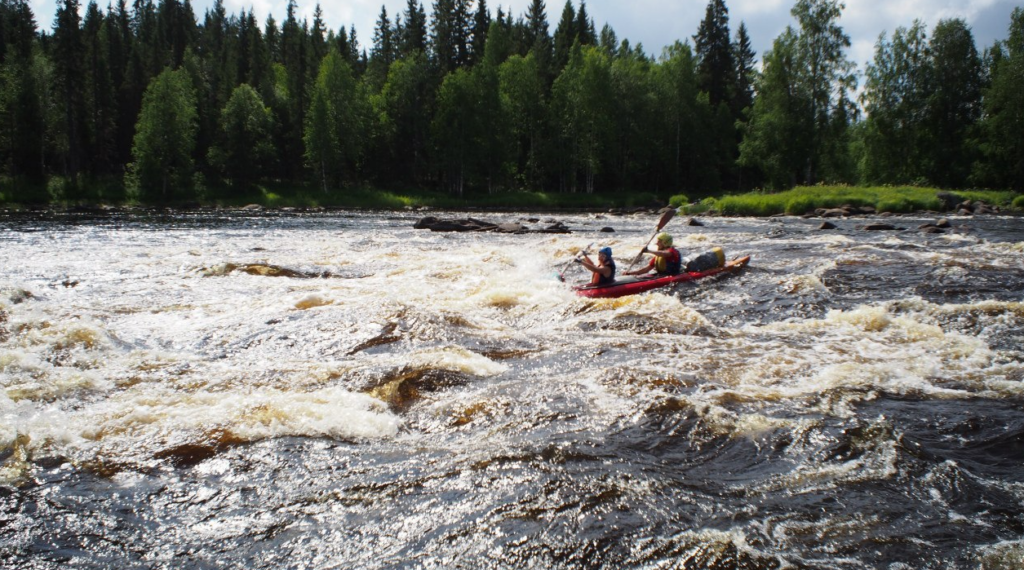Choosing a kayak can be a daunting task, especially for those who are just beginning their journey into the world of water sports. A kayak is a unique means of transport that allows you to enjoy nature, explore bodies of water and keep fit.
Types of kayaks
The first thing to consider when choosing a kayak is its type. There are several basic types of kayaks, each designed for specific conditions and paddling styles.
Recreational kayaks:
- Purpose: Suitable for calm water bodies such as lakes, slow-flowing rivers and coastal areas.
- Features: Wide and stable, provides comfort and easy handling. Ideal for beginners and those looking for relaxed walks.
- Examples: Old Town Vapor 10, Perception Sound 10.5.
Touring kayaks:
- Purpose: Designed for long hikes and travelling on water.
- Features: Long and narrow, provides high speed and good carrying capacity. Suitable for experienced kayakers who plan multi-day expeditions.
- Examples: Wilderness Systems Tsunami 125, Necky Looksha 17.
Whitewater kayaks (whitewater kayaks):
- Purpose: Designed for riding on rivers with strong currents and rapids.
- Features: Short and manoeuvrable, with rounded bow and stern. Provides maximum handling and stability in rough waters.
- Examples: Dagger Mamba, Jackson Kayak Zen.
Sea kayaks:
- Purpose: Ideal for coastal cruising and long offshore expeditions.
- Features: Long, narrow and stable, with sealed compartments for gear storage. Provide excellent performance in open waters.
- Examples: Current Designs Solstice GT, P&H Cetus.
Fishing Kayaks:
- Purpose: Specially equipped for fishing.
- Features: Wide and stable, equipped with additional fasteners for fishing rods, tackle boxes and other fishing accessories.
- Examples are Hobie Mirage Pro Angler 12, Old Town Predator PDL.
Materials
The materials used to make a kayak directly affect its weight, strength and performance. Let’s look at the main types of materials:
Plastic (polyethylene):
- Advantages: Durable, impact resistant and relatively inexpensive. Ideal for beginners and rough water riding.
- Disadvantages: Heavier and may lose their shape with prolonged exposure to sunlight.
- Examples: Wilderness Systems Tarpon 120, Perception Pescador Pro 10.
Composite materials (glass fibre, carbon fibre, Kevlar):
- Advantages: Lightweight, durable and provide excellent performance. Suitable for touring and sea kayaks.
- Disadvantages: More expensive and require careful handling.
- Examples: Eddyline Sitka XT, NDK Explorer.
Inflatables (PVC, Hypalon):
- Advantages: Lightweight, easy to transport and store. Suitable for recreational use and travelling.
- Disadvantages: Less rigid and can be prone to punctures.
- Examples: Advanced Elements AdvancedFrame, Sea Eagle 370 Pro.
Size and shape
The size and shape of a kayak play an important role in its performance, stability and usability. Choosing the right parameters depends on the type of water body you plan to paddle on, your level of experience and personal preferences.
Length
The length of the kayak significantly affects its speed, manoeuvrability and stability. Let’s consider each option in more detail:
Short kayaks (8-10 feet):
- Advantages: These kayaks are highly manoeuvrable and easy to handle, making them ideal for rough water, such as rivers with strong currents and rapids. The short length allows you to react quickly to changes in conditions and turn easily.
- Disadvantages: Short kayaks are less stable and do not offer as high a speed as longer models. They are also less efficient for long paddles on calm waters.
Medium kayaks (10-12 feet):
- Advantages: Versatile kayaks suitable for most conditions. They provide a good balance between stability and manoeuvrability. These kayaks are great for beginner kayakers and for those who want to paddle on lakes, slow flowing rivers or coastal areas.
- Disadvantages: Although they are versatile, medium kayaks may not be fast enough for long expeditions and may not be as manoeuvrable for rough water.
Long kayaks (12-16 feet):
- Advantages: These kayaks provide better glide and high speed, making them ideal for tourism and offshore expeditions. Long kayaks keep a better straight line, which is especially important on long distances and when sailing in open waters.
- Disadvantages: They are less manoeuvrable and can be difficult to control in narrow or rough waters. These kayaks require more space for storage and transport.
Width
The width of the kayak determines its stability and speed. It is important to consider your level of experience and the conditions in which you will be using the kayak.
Narrow kayaks (22-25 inches):
- Advantages: Narrow kayaks offer high speed and better manoeuvrability, making them ideal for experienced kayakers and competitions. They cut through the water more easily and require less effort to maintain high speed.
- Disadvantages: Less stable, making them not the best choice for beginners or for riding on calm bodies of water.
Wide kayaks (25-30 inches or more):
- Advantages: These kayaks offer high stability, which is ideal for beginners, fishing and relaxed paddling. Wide kayaks are easier to keep balanced, reducing the chance of tipping over.
- Disadvantages: They are slower and less manoeuvrable, which can be a limitation for those who want to reach high speeds or compete.
Body shape
The hull shape of the kayak affects its stability, speed and handling. Different hull shapes are suitable for different paddling conditions.
Flat bottom:
- Advantages: The flat bottom provides excellent stability, making these kayaks ideal for calm waters such as lakes and rivers with slow currents. They are comfortable for beginners and those who want a relaxed paddling or fishing experience.
- Disadvantages: Flat bottom kayaks are generally slower and less efficient in rough water or long distances.
V-shaped bottom:
- Advantages: The V-bottom improves the speed and handling of the kayak. It allows the kayak to cut through the water more easily and provides a smooth glide. These kayaks are suitable for tourism and offshore expeditions where speed and stability in open water are important.
- Disadvantages: Although the V-bottom improves performance, these kayaks can be less stable for beginners, especially in calm water conditions.
Round bottom:
- Advantages: The round bottom provides maximum manoeuvrability and allows the kayak to react quickly to changes in conditions. This makes them ideal for rough water and extreme conditions where quick reaction and control are important.
- Disadvantages: Less stable, making them not the best choice for beginners or for riding on calm bodies of water.
Additional factors
Apart from the basic parameters, there are several additional factors that can influence your choice:
- Seats: Comfortable seats with adjustable backrests and padding provide comfort for long journeys. Make sure the seat supports your back and easily adjusts to your individual needs.
- Examples: Wilderness Systems Phase 3 AirPro, Ocean Kayak Comfort Plus.
- Storage compartments: Airtight storage compartments help keep your belongings dry and safe. This is especially important for touring and sea kayaks where you need to store a lot of gear.
- Examples: Thigh straps, stern hatch, bow hatch.
- Steering system (rudder or skeg): Helps you stay on course in windy conditions and on long distances. The rudder is steered by your feet and helps you correct your direction, while the skeg stabilises the kayak.
- Examples: SmartTrack Rudder System, Vantage Seat Rudder Control.
- Paddles: The choice of paddle is also important. Lightweight oars made of carbon fibre or fibreglass make paddling easier, especially over long distances.
- Examples: Werner Camano, Bending Branches Angler Pro.
Choosing a kayak is an important step that depends on many factors, including your experience, paddling conditions and personal preferences. Considering the type of kayak, materials, size and shape will help you find the perfect one to maximise your enjoyment and safety on the water. Whether you are looking for relaxing lake trips, thrilling rafting on a rough river, or long offshore expeditions, choosing the right kayak will be the key to your success and enjoyment.
Harness the power of cashback with reBITme! Choose your kayak, activate your cashback and enjoy additional benefits from every purchase.





